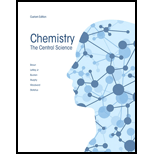
Concept explainers
(a)
To determine: The difference between a battery and fuel cell.
(a)
Answer to Problem 1DE
Solution: The major difference between a battery and fuel cells is that batteries are the self-contained system that does not require the continuous supply of reactants, while fuel cells require continuous supply of reagents.
Explanation of Solution
A battery is a portable source of energy that contains one or more voltaic cells. They are self-contained system that does not require the continuous supply of reactants.
Fuel cells are generally voltaic cell that convert chemical energy into electrical using conventional fuels such as
The major difference between a battery and fuel cells is that batteries are the self-contained system that does not require the continuous supply of reactants, while fuel cells require continuous supply of reagents.
(b)
To determine: If the fuel used in a fuel cell can be solid.
(b)
Answer to Problem 1DE
Solution: Yes, fuel used in a fuel cell can be solid.
Explanation of Solution
Solid fuels can also be used in fuel cell such as a hard ceramic compound of metals like calcium and zirconium oxide is used as electrolytes in fuel cells.
Yes, fuel used in a fuel cell can be solid. For example, hard ceramic compound of metals like calcium and zirconium oxide is used in fuel cells.
Want to see more full solutions like this?
Chapter 6 Solutions
CHEMISTRY:CENTRAL SCI.-W/ACCESS>CUSTOM<
 ChemistryChemistryISBN:9781305957404Author:Steven S. Zumdahl, Susan A. Zumdahl, Donald J. DeCostePublisher:Cengage Learning
ChemistryChemistryISBN:9781305957404Author:Steven S. Zumdahl, Susan A. Zumdahl, Donald J. DeCostePublisher:Cengage Learning ChemistryChemistryISBN:9781259911156Author:Raymond Chang Dr., Jason Overby ProfessorPublisher:McGraw-Hill Education
ChemistryChemistryISBN:9781259911156Author:Raymond Chang Dr., Jason Overby ProfessorPublisher:McGraw-Hill Education Principles of Instrumental AnalysisChemistryISBN:9781305577213Author:Douglas A. Skoog, F. James Holler, Stanley R. CrouchPublisher:Cengage Learning
Principles of Instrumental AnalysisChemistryISBN:9781305577213Author:Douglas A. Skoog, F. James Holler, Stanley R. CrouchPublisher:Cengage Learning Organic ChemistryChemistryISBN:9780078021558Author:Janice Gorzynski Smith Dr.Publisher:McGraw-Hill Education
Organic ChemistryChemistryISBN:9780078021558Author:Janice Gorzynski Smith Dr.Publisher:McGraw-Hill Education Chemistry: Principles and ReactionsChemistryISBN:9781305079373Author:William L. Masterton, Cecile N. HurleyPublisher:Cengage Learning
Chemistry: Principles and ReactionsChemistryISBN:9781305079373Author:William L. Masterton, Cecile N. HurleyPublisher:Cengage Learning Elementary Principles of Chemical Processes, Bind...ChemistryISBN:9781118431221Author:Richard M. Felder, Ronald W. Rousseau, Lisa G. BullardPublisher:WILEY
Elementary Principles of Chemical Processes, Bind...ChemistryISBN:9781118431221Author:Richard M. Felder, Ronald W. Rousseau, Lisa G. BullardPublisher:WILEY





